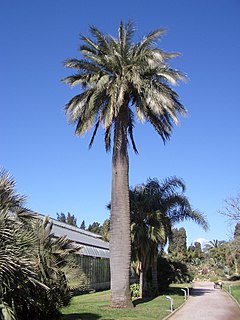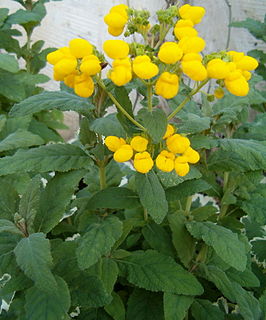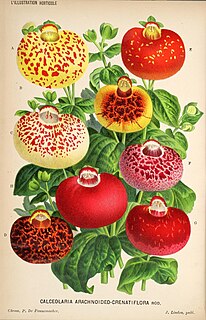
Araucaria araucana is an evergreen tree growing to 1–1.5 m (3–5 ft) in diameter and 30–40 m (100–130 ft) in height. It is native to central and southern Chile and western Argentina. Araucaria araucana is the hardiest species in the conifer genus Araucaria. Because of the prevalence of similar species in ancient prehistory, it is sometimes called a living fossil. It is also the national tree of Chile. Its conservation status was changed to Endangered by the IUCN in 2013 due to the dwindling population caused by logging, forest fires, and grazing.

The Missouri Botanical Garden is a botanical garden located at 4344 Shaw Boulevard in St. Louis, Missouri. It is also known informally as Shaw's Garden for founder and philanthropist Henry Shaw. Its herbarium, with more than 6.6 million specimens, is the second largest in North America, behind that of the New York Botanical Garden. The Index Herbariorum code assigned to the herbarium is MO and it is used when citing housed specimens.

Calceolaria, also called lady's purse, slipper flower and pocketbook flower, or slipperwort, is a genus of plants in the family Calceolariaceae, sometimes classified in Scrophulariaceae by some authors. This genus consists of about 388 species of shrubs, lianas and herbs, and the geographical range extends from Patagonia to central Mexico, with its distribution centre in Andean region. Calceolaria species have usually yellow or orange flowers, which can have red or purple spots. The Calceolaria Herbeohybrida group, also called C. herbeohybrida Voss, is a group of ornamental hybrids known only in cultivation, called florists slipperwort.

Calceolariaceae is a family of flowering plants in the order Lamiales that has been recently segregated from Scrophulariaceae. The family includes three genera, Calceolaria, Porodittia, and Jovellana, but analysis suggests that the monotypic Porodittia should be placed within Calceolaria. Recent molecular phylogenies that included Calceolaria have shown not only that this genus does not belong in Scrophulariaceae but also that it is the sister clade to the majority of the other families of the Lamiales. Morphological and chemical characters also support the separation of Calceolariaceae from Scrophulariaceae and other Lamiales. Some recent studies have supported a sister-group relationship between Calceolariaceae and Gesneriaceae. Given this close relationship, some authors opt to merge this family into Gesneriaceae as subfamily Calceolarioideae

Jubaea is a genus of palms with one species, Jubaea chilensis or Jubaea spectabilis, commonly known in English as the Chilean wine palm or Chile cocopalm, and palma chilena in Spanish. It is native to southwestern South America and is endemic to a small area of central Chile between 32°S and 35°S in southern Coquimbo, Valparaíso, Santiago, O'Higgins, and northern Maule regions.

Escalloniaceae is a family of flowering plants consisting of about 130 species in seven genera. In the APG II system it is one of eight families in the euasterids II clade (campanulids) that are unplaced as to order. More recent research has provided evidence that two of those families, Eremosynaceae and Tribelaceae, arose from within Escalloniaceae; the Angiosperm Phylogeny Website therefore merges these two families into Escalloniaceae, and also places the family alone in order Escalloniales.

Hipólito Ruiz López, or Hipólito Ruiz, was a Spanish botanist known for researching the floras of Peru and Chile during an expedition under Carlos III from 1777 to 1788. During the reign of Carlos III, three major botanical expeditions were sent to the New World; Ruiz and José Antonio Pavón Jiménez were the botanists for the first of these expeditions, to Peru and Chile.

Caucau River is minor river in the city of Valdivia, southern Chile. Caucau River acts as a regulating channel between Cruces River and Calle-Calle River forming the Isla Teja island in front of the city centre. It confluence with Calle-Calle River marks the beginning of Valdivia River. '

Geum quellyon, commonly called scarlet avens, Chilean avens, Double Bloody Mary, or Grecian rose, is a perennial herb in the family Rosaceae. It is native to the central and southern regions of Chile. G. quellyon has been introduced to other countries including Belgium, Bolivia, and the United Kingdom, where it was first planted in 1826.

Chusquea culeou, the Chilean bamboo, is a species of flowering plant in the grass family Poaceae. An evergreen bamboo native to South America, unlike most species within the genus Chusquea, it is frost-tolerant and thus widely cultivated in temperate regions.
Christian Ludwig (Luis) Landbeck was a prominent German ornithologist.

The facing heaven pepper, is a type of cone pepper, a group of cone-shaped, medium-hot chili peppers within the species Capsicum annuum. The species is native to Central America.

Calceolaria integrifolia, the bush slipperwort, is a shrub belonging to the genus Calceolaria and native to Argentina and Chile.

Calceolaria uniflora is a perennial plant of the genus Calceolaria, known as the slipperworts. It is originally from Tierra del Fuego in the southern part of South America.

Calceolaria Herbeohybrida Group, also called Calceolaria ×herbeohybrida Voss, is a cultivar group of hybrids in the genus Calceolaria, derived from three species from Chile and Argentina, C. crenatiflora, C. corymbosa and C. cana.

A cactarium or cactuario is a garden dedicated to the planting of cactus. Although they generally specialize in collecting cacti, they can also include other desert plants such as sabla, agaves or crassulaceae, although then we would be talking about a xeriscaping.

Berberis empetrifolia, sometimes called heath barberry, is a low, somewhat spiny shrub belonging to the barberries in the family Berberidaceae. The local names in Chile are zarcilla, monte negro and uva de la cordillera. It has small narrow entire leaves, and small yolk-colored flowers and later globose blue-black berries. The species originates south of 30ºS in Argentina and Chili, where it grows on sunny, often gravelly soils, and is sometimes planted as an ornamental elsewhere in temperate climates.

World Flora Online is an Internet-based compendium of the world's plant species.

Bomarea salsilla is a species of flowering plant in the genus Bomarea, native to Chile. It has gained the Royal Horticultural Society's Award of Garden Merit.

Calceolaria crenatiflora is a species of flowering plant in the pocketbook plant genus Calceolaria, family Calceolariaceae. It is native to central and southern Chile and southern Argentina. It has gained the Royal Horticultural Society's Award of Garden Merit as a warm temperate greenhouse ornamental. Along with Calceolaria corymbosa and Calceolaria cana it has contributed to the Calceolaria Herbeohybrida Group of cultivars.


















